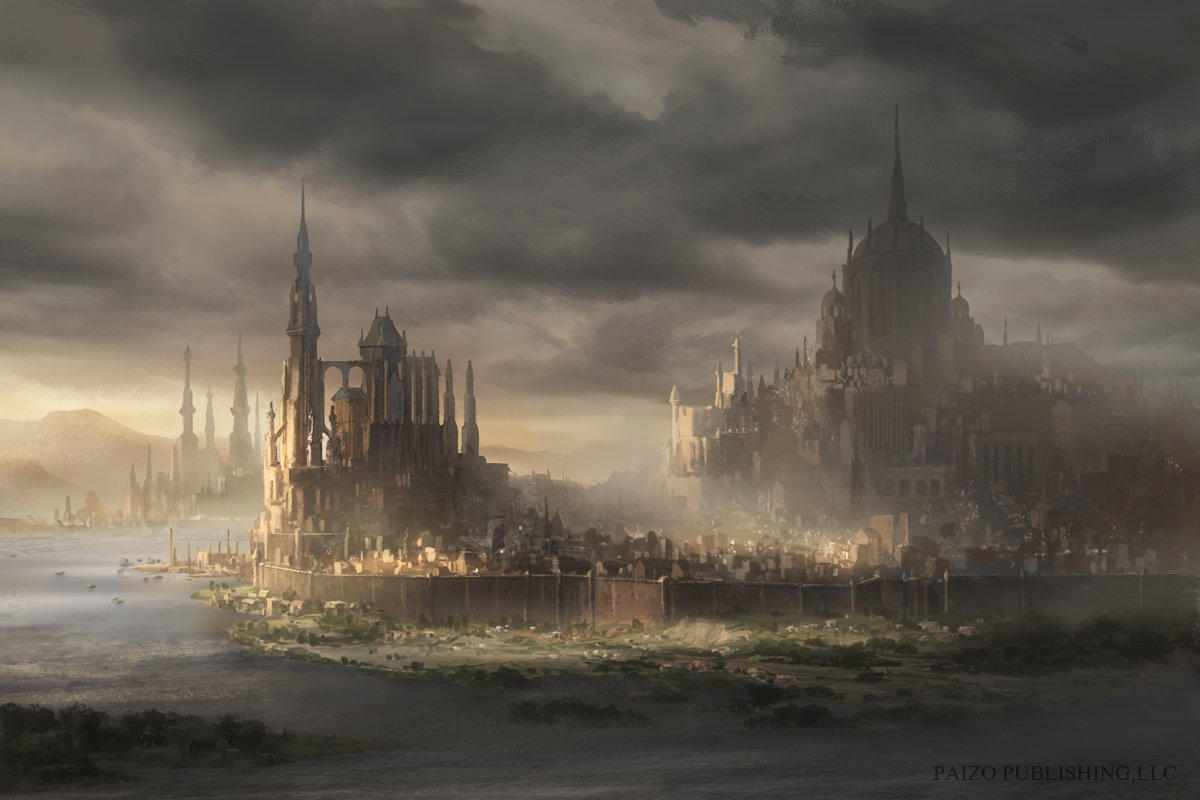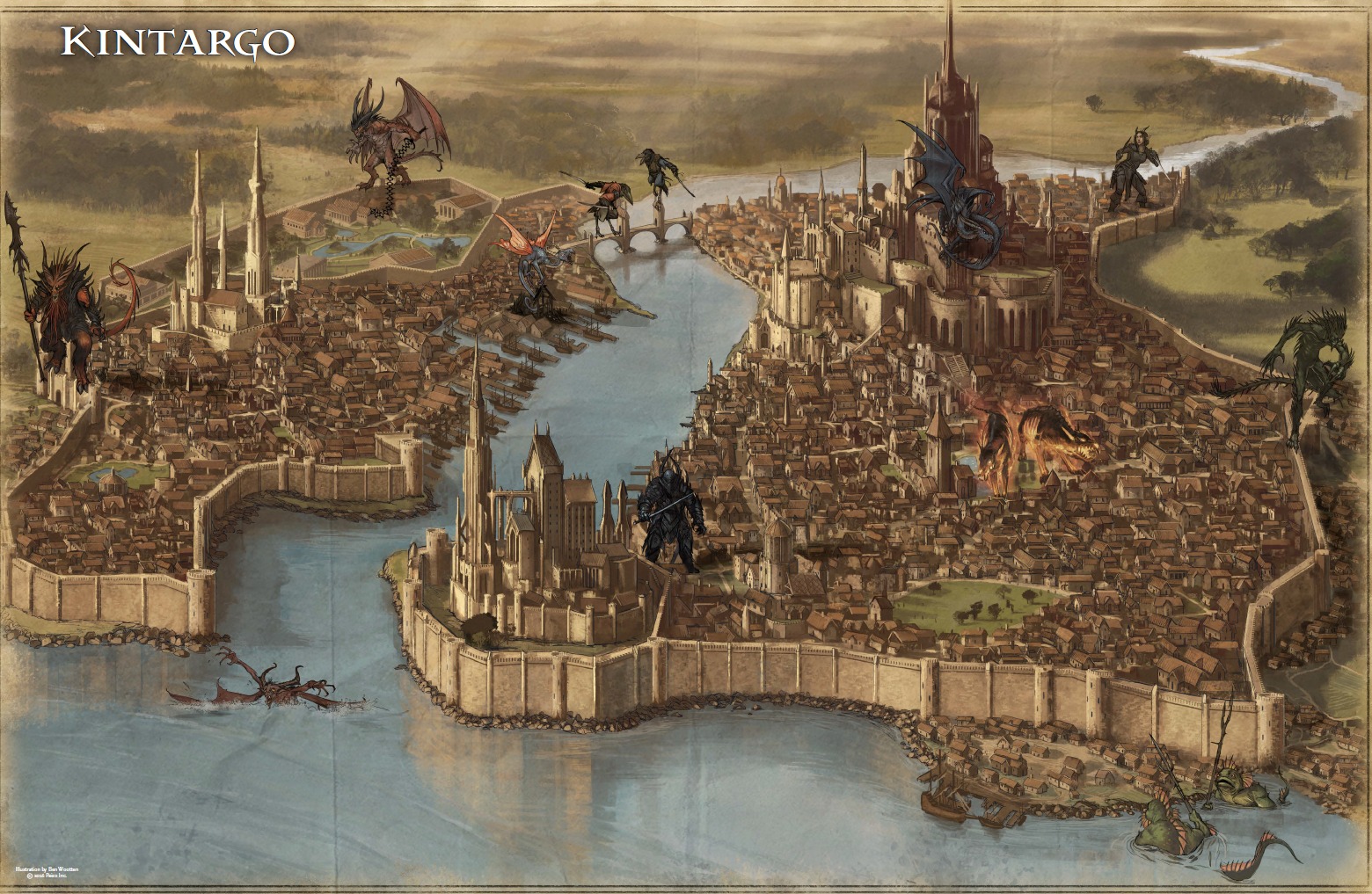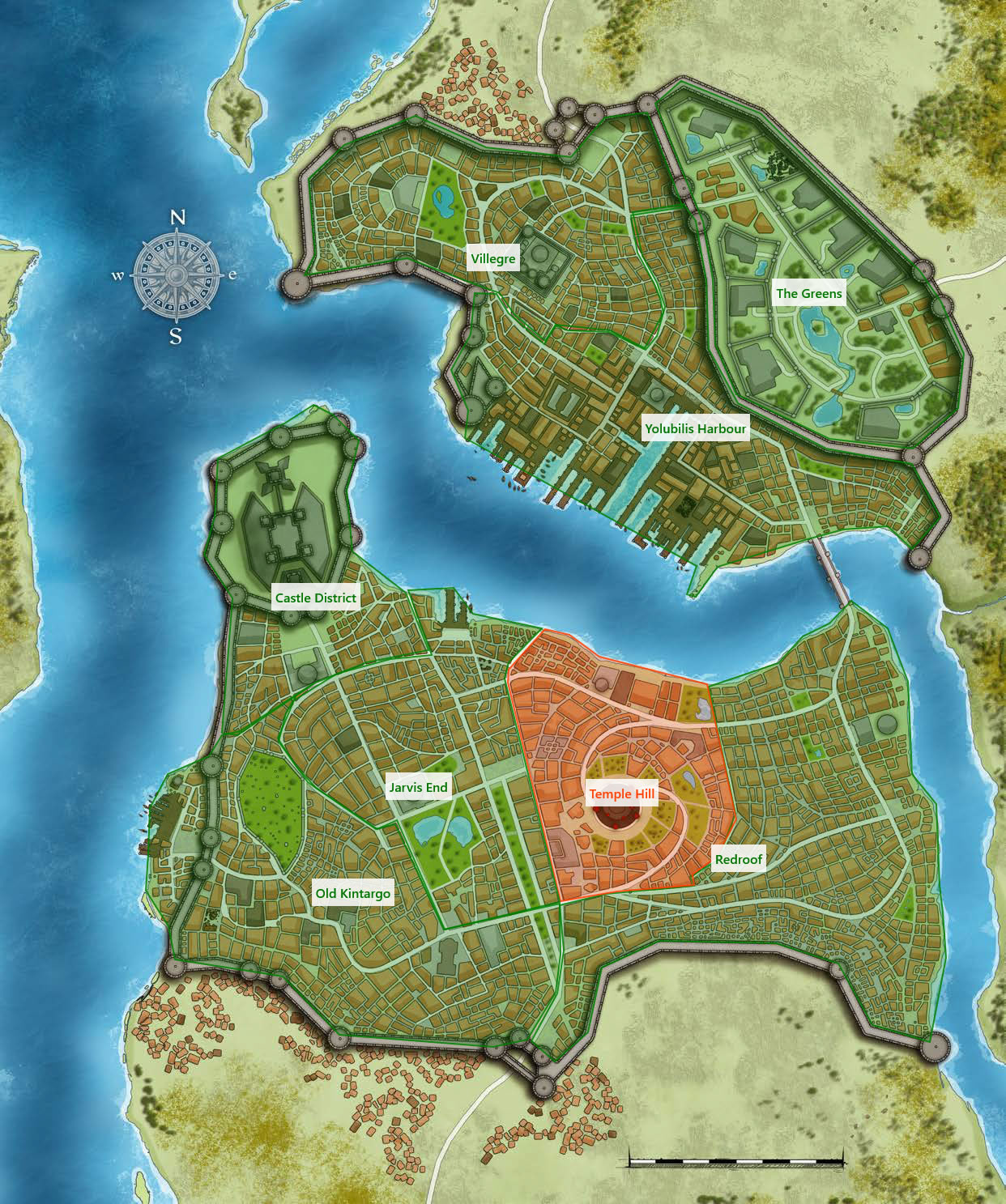Ravounel
Informationen
| Land: | Cheliax |
| Region: | Ravounel |
| Details: |
|
| Zitate: |
|
| Spezialitäten: |
Kintargo Flavor It's a small coastal plain wedged between mountains and a very cold ocean, so the weather doesn't get too hot in the summers, but winters get pretty cold. It's cloudy almost all the time thanks to the ocean winds and nearby mountains, and almost every day is marked by thick fog and light drizzle. The precipitation is mild enough that most locals make do with wool cloaks and coats. Thunderstorms and blizzards are extremely rare, but so are sunny days. Mold and mildew are the biggest enemies for homeowners, and most houses and businesses use cedar shavings or charcoal to try and manage humidity and musty smells. Food is plentiful thanks to the ocean and fertile, rain-soaked plains, but also spoils quickly thanks to the climate, so much of the city's traditional cuisine involves more salt, vinegar, or alcohol than other parts of Cheliax, and bread is less of a staple than rice and grains. The city itself is pretty hilly, and lower streets (especially Old Kintargo and Redroof) tend to flood in the rainier winter months |
Impressionen
Karte
Stadtteile
The city of Kintargo straddles the northeastern shore of the Yolubilis River and a large island named Argo that sits in the river's mouth. While the Yolubilis provides for Kintargo's economy by floating ships and turning waterwheels, the city sits downriver from various clay deposits, farms, mines, salt springs, and smelters. Sediments in the water give it a characteristic silvery shine when the sun strikes it at dawn and dusk. This, combined with the prodigious run of silver salmon that use the river every year to spawn and the use of silverflecked stone in many of the public buildings' facades, has given the settlement its most common nickname the Silver City.
Kintargo's independent spirit is founded in its selfsustaining economy. The Yolubilis River provides ample eels and freshwater trout in addition to the silver salmon run, while the cold, deep waters of Nisroch Bay teem with cod, shellfish, and tuna. In the foothills of the Menador Mountains, quarries yield granite and the city's iconic silver-flecked stone, while actual silver mines produce the bulk of the precious metal exported from the city. Beyond its wealth of seafood and minerals, Kintargo's third major export is something more mundane: salt. Local volcanic activity dots the North Plains with steaming brine prings, giving Kintargo enough salt resources to power its industrial needs and preserve its ocean harvests with plenty left over to trade. As with its fish and stone, Kintargan salt has a unique silver sheen to it, and many gourmands across the Inner Sea testify to this salt's superiority in flavor over all competitors'.
Kintargo's skyline is dominated by three structures: a castle, a temple, and a university. Castle Kintargo looms at the northernmost edge of Argo. The island's central hill is topped by a dome-shaped temple. Once a temple of Aroden, this structure has been claimed by the church of Asmodeus, and its iron-reinforced and reddraped walls stand out starkly amid the rest of the city's paler stone and wood structures. The southern half of Argo is low and swampy and prone to flooding, while on the north bank, sparse forests line the horizon. On the other side of the river, looming over the city's Villegre District, are the gleaming white towers of the city's infamous Alabaster Academy, stretching higher than any other structure in the settlement.
Kintargds city walls consist of two 10-footwide, 20-foot-tall parallel walls separated by an open pathway that measures nearly 8o feet across. The walls have battlements and walkways upon which city guards patrol, and numerous towers that seive as either barracks or holding cells.
Villegre
Villegre is Kintargo's scholastic center-an entire district that caters to the support of one of Cheliax's more distinguished universities, the Alabaster Academy. Those times are long past now, and today many of the buildings in Villegre stand empty, giving the neighborhood an eerie, almost forgotten feeling.
The Greens
Upwind of the river and fisheries, the Greens is Kintargo's noble district. A collection of noble houses and lush estates dominate this district.
Yolubilis Harbor
The Yolubilis River is split at the mouth by Argo, forming two branches that surround southern Kintargo and the tidal flats just south of the older section of the city. As Kintargo grew, the need for a more robust harbor grew as well; the relatively small stretch of harbor along Old Kintargo's west bank simply didn't suffice. And so this section of the north shore of the Yolubilis, where the river's waters were naturally deep and placid, became the city's new shipyard.
Castle District
Kintargo's Castle District serves not just as the city's military headquarters, but also the seat of its civilian government. Built upon a bluff; Castle Kintargo and the cluster of buildings that creep up to it from Old Kintargo and Jarvis End handle the day-to-day affairs of running the city.
Jarvis End
Named for the family responsible for the land reclamation project that saw much of Kintargo raised above the flood waters, Jarvis End is now the beating heart of Kintargo's nightlife, featuring numerous casinos, dance halls, playhouses, restaurants, and theaters, in addition to the city's winding foreign quarter.
Temple Hill
Temple Hill is the highest point on Argo and the original site ofKintargo's Temple of Aroden. Other faiths followed suit, building their temples on the central hill's slopes, but after Aroden died and House Thrune established the church of Asmodeus as Cheliax's state religion, the face of Temple Hill changed. Some of the old churches have been converted into government buildings, but a few temples of other deities remain.
Redroof
Most of Redroof's homes and small shops are built from brick and tile made from river-dredged red clay, rather than Kintargo's iconic white limestone, giving the neighborhood a distinctive look compared to the rest of the urban sprawl to the north and west. Redroof's brick buildings fare worse than limestone in the cold winters and hot summers, but are significantly more affordable for Kintargo's middle and lower classes.
Old Kintargo
Old Kintargo is, as its name implies, the oldest part of the city, and the neighborhood remains today as a chaotic mix of fisheries, industrial strongholds, neighborhoods, and warehouses, many of which have been buried and rebuilt numerous times. Living conditions range from squalid to fortified, and often ownership claims for buildings are sketchy at best, giving most of Old Kintargo an informal policy of land belonging to whoever makes use of it.




